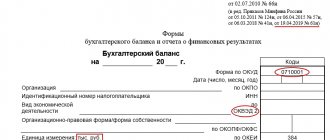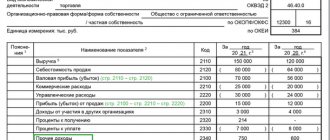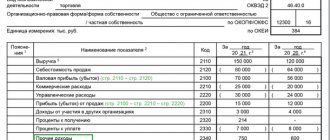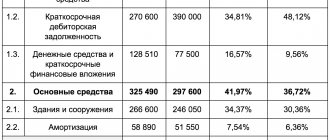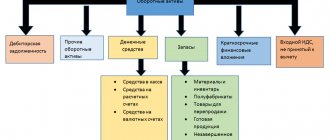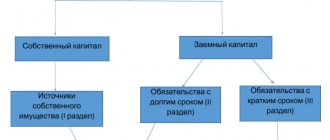How is work in progress accounted for and valued?
The volume of products that has not gone through all stages of the production process is considered work in progress (clause 63 of the Regulations on accounting and financial reporting in the Russian Federation, approved by order of the Ministry of Finance dated July 29, 1998 No. 34n).
This category also includes products that have not passed testing or technical acceptance. The above definition also applies to works and services. For companies with mass production, the assessment of refineries in accordance with clause 64 of the PBU can be carried out under the following conditions:
- according to the actual cost established in production;
- at cost, planned or included in the standard;
- by volume of material costs;
- by volume of direct costs.
If products are not mass-produced, but in units, then such enterprises are allowed to use only one point for reflection in the balance sheet - to account for refineries exclusively at actual cost.
How to determine the amount of equity capital?
According to the balance sheet, the value of the organization’s equity capital corresponds to the balance of line 1300 “Total for Section III,” i.e., the total amount for Section III “Capital and Reserves” of the balance sheet (Order of the Ministry of Finance dated July 2, 2010 No. 66n, clause 66 of the Order of the Ministry of Finance dated July 29, 1998 No. 34n).
Let us recall that the balance of capital and reserves in the balance sheet is determined as follows:
line 1310 “Authorized capital (share capital, authorized capital, contributions of partners)”
line 1320 “Own shares purchased from shareholders”
line 1340 “Revaluation of non-current assets”
line 1350 “Additional capital (without revaluation)”
line 1360 “Reserve capital”
line 1370 “Retained earnings (uncovered loss)”
It is from the organization's own capital that dividends are paid to participants. And upon termination of the organization’s activities, the size of its equity capital will show the amount of funds that is subject to distribution among participants. However, it is necessary to understand that equity can also be negative. This is possible in the case when the organization operates at a loss and its accumulated value exceeds the sum of other elements of equity capital (authorized, additional, reserve capital).
We talked in more detail about accounting for an organization's equity capital in a separate consultation.
Please note that if the calculation of equity is carried out to determine the maximum amount of interest taken into account in expenses on controlled debt, then the amount of equity will be equal to the sum of the balance of line 1300 and debt for taxes and fees (clause 4 of Article 269 of the Tax Code of the Russian Federation).
We talked in more detail about the use of the equity indicator when determining the interest on controlled debt taken into account in expenses here.
Indicator analysis
Net assets - what is it on the balance sheet (nuances)?
NA must be calculated to record the current financial condition of the enterprise. By studying their value, the owners draw conclusions about the efficiency and productivity of the business and make decisions on further investment or withdrawal of their funds. Net assets in the balance sheet, line 3600, demonstrate to the owners how profitable their cash investments and the institution's equity capital are.
NA is extremely necessary for analyzing financial and economic activities. They are also taken into account when paying dividends. NA must be positive, and their indicator must exceed the size of the authorized capital. When their value grows, management can conclude that the organization’s profits are growing.
Negative net assets can be observed in the first year of the enterprise’s operation - the most difficult period for operation, when the NAV can decrease and be significantly lower than the invested capital. In the case when an enterprise has been operating for a long period of time, and the NAV is negative, this indicates that the organization is operating ineffectively and investments are not profitable.
An increase in net assets is associated either with a change in their value (for example, revaluation of fixed assets) or with a change in the value of liabilities. Also, the increase in the NAV is made due to additional investments of the founders when additional capital is used.
capital
Related publications
The organization's balance sheet presents many important financial indicators that characterize the company's business, including the cost of equity capital.
At the moment, there are various ways to calculate such an indicator as equity capital - we will consider this below. One of the main methods for calculating equity capital is based on the balance sheet data and is indicated in line 1300 “Total for section 3”. It consists of authorized capital, additional capital (also arising during the revaluation of fixed assets), reserve fund, as well as retained earnings.
In Russian legislation, the concept of equity capital often refers to net assets, which are formed from the balance sheet data by subtracting from the company’s assets (line 1600) all liabilities (lines 1400 and 1500), debts of participants and adding future income. This method helps participants and investors assess the value of a business.
There is also a method for determining equity for tax purposes when it comes to calculating income tax and there is controlled debt, that is, debt under a loan or credit when the person who issued the loan or security is a foreign company owning more than 20% of the borrower's share capital (directly or indirectly).
We must not forget that debt must exceed more than three times the amount of equity capital. For such borrowings, interest is not taken into account in expenses in full, but within certain limits (the “thin capitalization” rule). When we calculate equity capital for this case, then equity in the balance sheet is line 1300 “Total according to section. Ш" plus the borrower's tax debt.
I note that when it comes to tax arrears, this does not include arrears of contributions to funds (Pension Fund, Social Insurance Fund, Mandatory Health Insurance Fund).
Analysis of financial ratios
Borrowed capital on balance sheet: line
To draw conclusions about the financial position of a company, it is necessary not only to analyze absolute indicators, but also to calculate the relationships between them, i.e. – coefficients. They, like absolute numbers, also need to be studied over time in order to draw conclusions about business development trends. Let's consider the main financial indicators that can be obtained based on financial statements.
- Profitability is the ratio of net profit to revenue or assets. To calculate it, not only the balance sheet is used, but also another main accounting form - the income statement.
If a company operates successfully, then not only its revenue and net profit should grow, but also its profitability percentage.
Net assets
The concept of private equity is regulated by the Civil Code of the Russian Federation, defining them as a liquidity criterion for an organization, regardless of its organizational and legal form. Net assets are the difference reflected in the balance sheet between the value of all types of property of the institution (fixed and cash assets, land property, etc.)
d.) and the amount of established obligations (accounts payable of the organization). NA is the own capital funds of any enterprise, in other words, the capital property that will remain at the disposal of the institution after the repayment of all debts incurred to creditors and the sale of property assets.
The calculation of the value of net assets on the balance sheet must be carried out annually during the preparation and preparation of annual financial statements. The calculated NAV value demonstrates the real financial position of the enterprise as of the current date. The amount of net assets in the balance sheet is line 3600 in section 3 of the Statement of Changes in Capital.
Explanation of the balance sheet according to the lines of section 2
Explanation of balance sheet lines (1230, etc.)
In the 2nd section of the balance sheet there are lines reflecting the value of the most liquid assets available in the company at the reporting date - working capital:
| Balance sheet line | Decoding | How is the balance formed and from what accounts is it taken? | |
| Name | code | ||
| Reserves | 1210 | Explanation of line 1210 “Inventories” in the balance sheet includes:
| D/t 10 + D/t 15 + D/t 16 (or – K/t 16) + D/t 20 + D/t 21 + D/t 23 + D/t 28 + D/t 29 + D/ t 41+ D/t 43 – K/t 42– K/t 14 + D/t 44 + D/t 45 |
| VAT on purchased assets | 1220 | Debit balance of the account. 19 “VAT on purchased MC” | D/t 19 |
| Accounts receivable | 1230 | Combine debit balances on settlement accounts with suppliers, customers, employees - 60, 62, 70, 71, 73 (excluding long-term interest-bearing loans on account 73/1), 75, 68, 69.76 (VAT on advances reflected on these are not taken into account). The credit balance of the account is subtracted from the resulting value. 63 “Reserves for doubtful debts”, if a reserve was created | D/t 60 + D/t 62 – D/t 63 + D/t 68 + D/t 69 + D/t 70 + D/t 71 + D/t 73 (except for loans on account 73-1) + D/t 75 + D/t 76 (minus VAT on advances issued and received) |
| Financial investments (except cash equivalents) | 1240 | Investments in short-term periods (less than a year) to make a profit. Sum up the debit balances on accounts 55/3 and 58 (minus the credit balance of the reserve for impairment of short-term investments on account 59), 73 | D/t 58 – K/t 59 + D/t 55/3 + D/t 73-1 (for short-term transactions) |
| Cash and cash equivalents | 1250 | They generate information about the balances of funds in bank accounts and the cash desk of the company, for which they sum up the debit balances on accounts 50 (except for the subaccount for monetary documents 50/3), 51, 52, 55, 57, 58 (in terms of cash equivalents - securities , shares, etc.) | D/t 50 (except 50/3) + D/t 51 + D/t 52 + D/t 55 (except 55/3) + D/t 57 + D/t 58 (for investments in securities) |
| Other current assets | 1260 | The value of assets not included in the listed lines, for example, the debit balance of an account. 50/3 (when taking into account monetary documents), the amount of shortages and losses in the account. 94 | D/t 50/3 + D/t 94 |
| Total for Section II | 1200 | Total line by section | Sum of filled section lines |
| BALANCE | 1600 | Total for balance sheet assets | Sum of lines 1100 and 1200 |
What accounting data is used. when filling out line 1300 “Capital and reserves”
when filling out line 1300 “Capital and reserves” When filling out the line “Capital and reserves”, data on credit balances on accounts 80, 82, 83, debit balance on account 81, balance on account 84 as of the reporting date can be used.
┌───────────────────────┐ ┌─────────────────┐ ┌─────────┐ ┌─────────┐
│Line 1300 “Capital and │ │Credit balances│ │Debit│ │Balance by│
│reserves" of Accounting│ = │accounts 80, 82,│ - │balance on│ + │account 84 │
│balance │ │83 │ │account 81 │ — │ │
└───────────────────────┘ └─────────────────┘ └─────────┘ └─────────┘
The comparative indicators of the line “Capital and reserves” (indicators as of December 31 of the previous year and as of December 31 of the year preceding the previous one) are transferred from the Balance Sheet for the previous year.
For reference: Small businesses may not perform a retrospective recalculation of comparative indicators of financial statements...
Small businesses (except for issuers of publicly offered securities) may not perform a retrospective recalculation of comparative financial statements. These organizations have the right to reflect the consequences of changes in accounting policies prospectively, except in cases where a different procedure is established by the legislation of the Russian Federation and (or) the regulatory legal act on accounting (clause 15.1 of PBU 1/2008).
Retrospective recalculation of comparative indicators of financial statements is not carried out by such organizations even in the case of correction of errors of previous years identified after the approval of the financial statements for the reporting year in which the errors were made (clauses 9, 14 of PBU 22/2010).
From November 16, 2014, simplified methods of accounting, including simplified financial statements, are not entitled to be used by commercial organizations - small businesses if they are microfinance organizations or their accounting statements are subject to mandatory audit (clause 1, 4, part 5 Article 6 of Law No. 402-FZ).
Filling example
lines 1300 “Capital and reserves”
EXAMPLE 27
Indicators for accounts 80, 82, 83 and 84 in the accounting of an organization - a small business entity (indicator for account 81 is missing):
rub.
| Index | As of the reporting date (December 31, 2014) |
| 1 | 2 |
| 1. On account credit 80 | 10 000 |
| 2. On the credit of account 82 | 2000 |
| 3. On the credit of account 83 | 450 000 |
| 4. On the credit of account 84 | 27 218 157 |
Fragment of the Balance Sheet for 2013
| Indicator name | Code | As of December 31, 2013 | As of December 31, 2012 | As of December 31, 2011 |
| 1 | 2 | 3 | 4 | 5 |
| Capital and reserves | 1300 | 27 190 | 22 471 | 15 640 |
Solution
The indicator for line 1300 “Capital and reserves” is equal to:
as of December 31, 2014 - RUB 27,680 thousand. (RUB 10,000 + RUB 2,000 + RUB 450,000 + RUB 27,218,157);
as of December 31, 2013 - RUB 27,190 thousand;
as of December 31, 2012 - RUB 22,471 thousand.
A fragment of the Balance Sheet in Example 27 will look like this.
| Indicator name | Code | As of December 31, 2014 | As of December 31, 2013 | As of December 31, 2012 |
| Capital and reserves | 27 680 | 27 190 | 22 471 |
3.6.1.8. Line 1410 “Long-term borrowed funds”
For this line, small business organizations reflect information on long-term loans and borrowings attracted by the organization (the repayment period of which as of the reporting date exceeds 12 months) (paragraph 2, paragraph 17 of PBU 15/2008, paragraphs 19, 20 of PBU 4 /99).
Attention!
If the repayment period of borrowed funds previously presented in the Balance Sheet as long-term liabilities is less than 12 months at the reporting date, these liabilities are presented as short-term (Letter of the Ministry of Finance of Russia dated January 28, 2010 N 07-02-18/01).
Attention!
Small businesses, with the exception of issuers of publicly placed securities, have the right to recognize all borrowing costs as other expenses (clause 7 of PBU 15/2008). However, this rule does not affect the procedure for determining interest debt reflected in the Balance Sheet as part of the indicator in line 1410 “Long-term borrowed funds” or line 1510 “Short-term borrowed funds.”
Since November 16, 2014
Equity. Balance formula
Own capital consists of balance sheet liability items - authorized capital, share capital and contributions of partners (line 1310), additional capital (line 1350), reserve fund (line 1360), retained earnings (line 1730) and so on.
The formula for equity on the balance sheet is quite simple. Own capital in the balance sheet is line 1300 “Total” under section III “Capital and reserves”. For example, let’s find our own funds in the balance sheet of Soyuz LLC. Data as of December 31:
— authorized capital — 10 thousand rubles;
— revaluation of non-current assets — 50 thousand rubles;
— retained earnings — 1000 thousand rubles.
Own capital is equal to 1,060 thousand rubles. (10 thousand rubles + 50 thousand rubles + 1000 thousand rubles).
The amount of authorized (share) capital is reflected in the balance sheet in accordance with the registered charter of the company; it represents the contributions of the founders (participants, shareholders) of the company. For LLCs, the minimum size of the capital is 10,000 rubles, for public joint-stock companies 100,000 rubles, and for non-public joint-stock companies the same 10,000 rubles. It can be made both in cash and in non-cash (securities, property rights, etc.), and there must be an independent assessment of such a contribution. State-owned companies have an authorized capital instead of an authorized capital. You can find the size of the authorized capital in line 1310 of the balance sheet.
When a company overvalues non-current assets, when selling shares or shares, receives an amount in excess of the nominal value, or receives gratuitous assistance as a contribution to the property of the company, then this is accounted for as additional capital.
A reserve fund is created from the company's profits to compensate for possible losses, including in the case of outstanding accounts receivable. The amount of the reserve is determined separately for each doubtful debt. Joint-stock companies are required to create it; for an LLC, such an obligation is provided for in the charter. In the balance sheet, reserve capital is reflected in line 1360 “Reserve capital”.
When the profit remains at the disposal of the company, has not gone to taxes and has not been distributed among the participants (shareholders), it is reflected in account 84 “Retained earnings (uncovered loss).” Retained earnings have the right to be spent only by decision of the owners; they can use it for dividends or to increase the authorized capital. You can also use profits to cover last year's losses.
Section 3 refers to the liability side of the balance sheet and contains digital indicators characterizing the capital and reserves of the organization, namely:
· Own shares purchased from shareholders.
· Revaluation of non-current assets.
· Retained earnings (uncovered loss).
Authorized capital (share capital, authorized capital, contributions of partners) (line 1310) - indicates the amount of the authorized capital of the organization at the end of the reporting period, fixed in the constituent documents.
The balance sheet indicators on line 1310 do not contain information about changes in capital.
The explanation for line 1310 “Authorized capital (share capital, authorized capital, contributions of partners)” of the balance sheet is the Statement of Changes in Capital.
Please note: The indicator in line 1310 of the balance sheet must correspond to the indicator in the “Authorized Capital” column of the line “Capital Amount as of December 31, 2013.” (line 3300 ) Statement of changes in capital.
Own shares purchased from shareholders (line 1320) - indicates the amount of the debit balance in account 81 “Own shares (shares)” at the end of the reporting period.
Own shares/shares purchased from shareholders/participants are reflected in the financial statements in the amount of actual costs for their redemption, regardless of the nominal value.
Please note: The indicator in line 1320 of the balance sheet must correspond to the indicator in the column “Own shares purchased from shareholders” of the line “Capital value as of December 31, 2013.” (line 3300 ) Statement of changes in capital.
This indicator is reflected in parentheses.
Revaluation of non-current assets (line 1340) – the credit balance is indicated in account 83 “Additional capital”, in terms of revaluation of non-current assets, at the end of the reporting period, taking into account the revaluation carried out as of December 31, 2013.
Please note: Revaluation of fixed assets is carried out by recalculating their residual or current (replacement) value (if this object was revalued previously), and the amount of depreciation accrued for the entire period of use of the object (clause 15 of PBU 6/01).
Revaluation of intangible assets is carried out by recalculating their residual value (clause 19 of PBU 14/2007).
Additional capital (without revaluation) (line 1350) – indicates the amount of the credit balance in account 83 “Additional capital” at the end of the reporting period, minus the amounts of the credit balance formed in connection with the revaluation of assets.
Amounts of additional capital include, for example, the excess of the selling price of shares/shares over their nominal value.
Reserve capital (line 1360) – indicates the amount of the organization’s reserve capital at the end of the reporting period.
This line reflects the amounts of reserve (and other) funds formed in accordance with the constituent documents and provisions of the current legislation.
In accordance with clause 1 of Article 30 of Law No. 14-FZ “On Limited Liability Companies”, the Company may create a reserve fund and other funds in the manner and in the amounts established by the company’s charter.
In accordance with clause 1 of Article 35 No. 208-FZ “On Joint-Stock Companies,” a reserve fund is created in the company in the amount provided for by the company’s charter, but not less than 5 percent of its authorized capital.
The reserve fund of the company is formed through mandatory annual contributions until it reaches the size established by the charter of the company.
The amount of annual contributions is provided for by the company's charter, but cannot be less than 5 percent of net profit until the amount established by the company's charter is reached.
The company's reserve fund is intended to cover its losses, as well as to repay the company's bonds and repurchase the company's shares in the absence of other funds.
The reserve fund cannot be used for other purposes.
We recommend that the procedure for creating reserve (and other) funds, as well as the procedure for contributions to these funds, be fixed in the accounting policy for accounting purposes and reflected in the explanatory note to the statements.
Please note: The indicator in line 1360 of the balance sheet must correspond to the indicator in the column “Reserve capital” in the line “Capital value as of December 31, 2013.” (line 3300 ) Statement of changes in capital.
Retained earnings (uncovered loss) (line 1370) – indicates the amount of retained earnings (uncovered losses) reflected at the end of the year in account 84 “Retained earnings (uncovered loss)”.
Please note: The indicator in line 1370 of the balance sheet must correspond to the indicator in the column “Retained earnings (uncovered loss)” of the line “Capital value as of December 31, 2013.” (line 3300 ) Statement of changes in capital.
The indicator on line 1370 is indicated without brackets if the balance is positive (when reflecting retained earnings) and in parentheses if the result is negative (when reflecting uncovered losses).
Total for section III (line 1300) – indicates the total amount of the organization’s equity capital at the end of the reporting period.
Line 1300 = line 1310 + line 1320 + line 1340 + line 1350 + line 1360 + line 1370.
Please note: The indicator in line 1300 of the balance sheet must correspond to the indicator in the “TOTAL” column of the line “Capital value as of December 31, 2013.” (line 3300 ) Statement of changes in capital.
Laws and regulations
When preparing external reporting, it is necessary to be guided by the following regulatory documents of all four levels of regulatory regulation, among which the most important are:
Laws and regulations
- Federal Law of November 21, 1996 No. 129-FZ “On Accounting” (as amended on July 23, 1998, March 28, December 31, 2002, January 10, May 28, June 30, 2003, November 3 2006, November 23, 2009);
- Regulations on accounting and financial reporting in the Russian Federation, approved by order of the Ministry of Finance of the Russian Federation dated July 29, 1998 No. 34n (as amended on December 30, 1999, March 24, 2000, September 18, 2006, March 26, 2007 );
- PBU 1/2008 Accounting Regulations “Accounting Policy of the Organization”, Appendix No. 1 to Order of the Ministry of Finance of the Russian Federation dated October 6, 2008 No. 106n (as amended on March 11, 2009);
- PBU 4/99 “Accounting statements of organizations”, approved by order of the Ministry of Finance of the Russian Federation dated July 6, 1999 No. 43n (as amended by order of the Ministry of Finance of the Russian Federation dated September 18, 2006 No. 115n);
- Order of the Ministry of Finance of the Russian Federation dated July 22, 2003 No. 67n “On the forms of financial statements of organizations” (as amended by Order of the Ministry of Finance of the Russian Federation dated September 18, 2006 No. 115n);
- Order of the State Statistics Committee of the Russian Federation and the Ministry of Finance of the Russian Federation dated November 14, 2003 N 475/102n “On Codes of indicators of annual financial statements of organizations, data on which are subject to processing by state statistics bodies”;
- Order of the Ministry of Finance of the Russian Federation dated December 30, 1996 N 112 “On Methodological recommendations for the preparation and presentation of consolidated financial statements” (as amended on May 12, 1999);
- Chart of accounts for accounting financial and economic activities of organizations and Instructions for its application, approved by order of the Ministry of Finance of the Russian Federation dated October 31, 2000 No. 94n, (as amended on May 7, 2003, September 18, 2006), as well as individual recommendations and instructions regulating the procedure for preparing financial statements, approved by the Ministry of Finance of the Russian Federation.
We will also talk about the new procedure for confirming Decisions of general meetings of JSCs and LLCs, i.e. on the specifics of approving annual financial statements. Let us remind you about the new forms of tax returns, which must be reported for 2014, and the new deadlines for submitting calculations for insurance premiums.
List of issues discussed in it:
- Composition of annual financial statements.
- New procedure for calculating net assets.
- Features of reporting by small businesses.
- Changes in the list of organizations whose reporting is subject to mandatory audit.
- Audit report: where to submit?
- Responsibility for failure to conduct a mandatory audit.
- When are reports considered prepared?
- New procedure for confirming decisions of general meetings of JSCs and LLCs (approval of financial statements).
- New tax return forms for 2014.
How to calculate: formula for calculating net assets
The calculation of net assets is regulated by the Ministry of Finance of the Russian Federation through Order No. 84n dated August 28, 2014, which defines the concept of net assets - the formula. Its enforcement applies to the following types of organizational and legal forms of enterprises:
- public and non-public joint stock companies;
- LLC - limited liability company;
- SUE and MUP;
- production and housing savings cooperatives;
- business partnerships.
How to calculate net assets on the balance sheet is defined in Order No. 84n.
To calculate the NA, you can use the difference between their cost and liabilities:
Let's decipher the main terms of this formula:
- VAO - non-current (JSC);
- OJSC - current JSC;
- ZU - debts of the founders to the institution for filling shares in the management company;
- ZBA - debt from the repurchase of own securities (shares);
- DO - long-term liabilities;
- KO - short-term liabilities;
- DBP is the profitability expected in future periods.
The formula for net assets on the balance sheet is as follows:
The value of net assets in the balance sheet, line 3600, is entered after its calculation in the “Report on Changes in Capital”, form according to OKUD 0710003.
All settlement procedures must be carried out in writing and certified by the accounting department, on a separate form developed by the enterprise independently and enshrined in the accounting policy.
The procedure for filling out a simplified statement of financial results
| Report line | Accounting account |
| 2110 "Revenue" | Difference of indicators: · Turnover on the credit of the “Revenue” sub-account to the “Sales” account · Turnover on the debit of the “VAT” sub-account to the “Sales” account |
| 2120 “Expenses for ordinary activities” | Amount on debit of subaccounts to account 90 “Sales”, on which accounting is kept: · Cost of sales · Business expenses · Administrative expenses |
| 2330 “Interest payable” | The amount of accrued interest on loans for the current year is indicated. The indicator is indicated in brackets, no minus sign is used. |
| 2340 “Other income” | Difference of indicators: · Turnover on the credit of the sub-account “Other income” to account 91 “Other income and expenses” · Turnover on the debit of the sub-account “VAT” to account 91 “Other income and expenses” |
| 2350 “Other expenses” | Difference of indicators: · Turnover on the debit of the subaccount “Other expenses” to account 91 “Other income and expenses” · Indicator for line 2330 “Interest payable” The indicator is indicated in brackets, no minus sign is used. |
| 2410 “Profit taxes (income)” | · If an organization pays income tax, then the value of line 180 of sheet 02 of the income tax declaration is recorded · If the organization is on the simplified tax system (income), then the difference in the indicators on lines 133 and 143 of section 2.1.1 of the simplified tax return is indicated · If the organization is on the simplified tax system (income minus expenses), then indicate the indicator on line 273 of section 2.2 of the declaration under the simplified tax system. When paying the minimum tax, the indicator is indicated on line 280 of section 2.2 of the declaration according to the simplified tax system. · If the organization is on UTII, then the amount of UTII for all quarters is indicated. The indicator is indicated in brackets, no minus sign is used. |
| 2400 “Net profit (loss)” | Calculate the value as follows: page 2110 – page 2120 – page 2330 + page 2340 – page 2350 – page 2410 |
Code designations in the form of a balance sheet are necessary for statistical authorities to formulate final indicators for economic sectors in the context of individual indicators of the activities of business entities. The balance sheet with the entered codes is filled in at the end of the year. The ciphers are set in four-digit format.
Conclusions about what a change in indicator means
If the indicator decreases
Usually a positive factor
Notes
The indicator in the article is considered from the point of view not of accounting, but of financial management. Therefore, sometimes it can be defined differently. It depends on the author's approach.
In most cases, universities accept any definition option, since deviations according to different approaches and formulas are usually within a maximum of a few percent.
The indicator is considered in the main free online financial analysis service and some other services
If you need conclusions after calculating the indicators, please look at this article: conclusions from financial analysis
If you see any inaccuracy or typo, please also indicate this in the comment. I try to write as simply as possible, but if something is still not clear, questions and clarifications can be written in the comments to any article on the site.
The financial analysis:
- Reserves for future expenses and payments (or estimated liabilities) 1540 Definition Reserves for future expenses and payments (or estimated liabilities) 1540 are estimated liabilities, the estimated period of fulfillment of which does not exceed 12 months Despite not ...
- TOTAL for section IV 1400 Definition of TOTAL for section IV 1400 is the sum of indicators for lines with codes 1410 - 1450 - the total amount of long-term liabilities of the organization Availability and growth...
- Other liabilities 1450 Definition Other liabilities 1450 are other liabilities of the organization, the maturity of which exceeds 12 months, which are not included in other groups of the 4th section of the balance sheet. Their presence...
- Estimated liabilities 1430 Definition Estimated liabilities 1430 are estimated liabilities, the expected fulfillment period of which exceeds 12 months. Despite not the simplest definition, in fact, estimated liabilities are...
- BALANCE 1700 Definition BALANCE 1700 is the total value of the organization's liabilities. This is the sum of the indicators on lines 1300, 1400, 1500, that is, equity capital, long-term liabilities and short-term...
- TOTAL for section III 1300 Definition of TOTAL for section III 1300 is the sum of indicators for lines with codes 1310 - 1370 and reflects the total amount of the organization’s own capital: 1310 “Authorized capital ...
- TOTAL for section I 1100 Definition of TOTAL for section I 1100 is the sum of indicators on the lines of the balance sheet with codes 1110 - 1170 - the total value of the organization’s non-current assets:...
- Deferred tax liability 1420 Definition Deferred tax liability 1420 is a liability in the form of a portion of deferred income taxes that will result in an increase in income taxes in one or...
- Borrowed funds 1510 Definition Borrowed funds 1510 are short-term (the repayment period of which does not exceed 12 months) loans and borrowings received by the organization. They may include...
- Other short-term liabilities 1550 Definition Other short-term liabilities 1550 are other obligations of the organization, the repayment period of which does not exceed 12 months: targeted financing received by developer organizations from investors and generating ...
Which line of the balance sheet contains the equity indicator
Calculating equity capital in the balance sheet using the Ministry of Finance method is a procedure that involves using data from the following sections of the balance sheet:
- lines 1400 (long-term liabilities);
- lines 1500 (current liabilities);
- lines 1600 (assets).
Also, to calculate equity capital, you will need information showing the amount of debts of the founders of a business company (let’s agree to call them DOO), if any (they correspond to the debit balance of account 75 as of the reporting date), as well as deferred income, or DBP (account credit 98 ).
For information on what kind of transactions are reflected in the accounting operations of the insurance company, read the material “Procedure for accounting for the equity capital of an organization (nuances).”
The structure of the formula by which net assets and at the same time equity capital in the balance sheet are determined is as follows. Necessary:
- Add the indicators along lines 1400, 1500.
- Subtract from the number obtained in paragraph 1 those that correspond to the credit of account 98 (for income in the form of assistance from the state and gratuitous receipt of property).
- Subtract the debit balance of account 75 from the number on line 1600.
- Subtract the result obtained in step 2 from the number obtained in step 3.
Thus, the formula for equity capital according to the Ministry of Finance will look like this:
Sk = (line 1600 – DUO) – ((line 1400 + line 1500) – DBP).
For information about who should apply this calculation procedure and how its result is formalized, read the article “The procedure for calculating net assets on the balance sheet - formula 2019-2020.”
Conclusions about what a change in indicator means
If the indicator increases
Usually a positive factor, especially if accompanied by faster revenue and profit growth. Otherwise, it is a negative factor.
If the indicator decreases
Usually a positive factor if accompanied by an increase in revenue and profit. Otherwise, it is a negative factor, especially if revenue and profit are declining faster than the decline in total assets.
Notes
The indicator in the article is considered from the point of view not of accounting, but of financial management. Therefore, sometimes it can be defined differently. It depends on the author's approach.
In most cases, universities accept any definition option, since deviations according to different approaches and formulas are usually within a maximum of a few percent.
The indicator is considered in the main free online financial analysis service and some other services
If you need conclusions after calculating the indicators, please look at this article: conclusions from financial analysis
If you see any inaccuracy or typo, please also indicate this in the comment. I try to write as simply as possible, but if something is still not clear, questions and clarifications can be written in the comments to any article on the site.
The financial analysis:
- TOTAL for section I 1100 Definition of TOTAL for section I 1100 is the sum of indicators on the lines of the balance sheet with codes 1110 - 1170 - the total value of the organization’s non-current assets:...
- Inventories 1210 Definition Inventories 1210 are the organization’s material and production inventories (MPS) - assets: used as raw materials, supplies, etc. in the production of products for sale (for performing work, for...
- Deferred tax assets 1180 Definition Deferred tax assets 1180 are an asset that will reduce income taxes in future periods, thereby increasing after-tax profits. The presence of such an asset...
- TOTAL for section II 1200 Definition of TOTAL for section II 1200 is the sum of indicators on the lines of the balance sheet with codes 1210 - 1260 and reflects the total value of the organization’s current assets:...
- Accounts receivable 1230 Definition Accounts receivable 1230 is the debt of buyers, customers, borrowers, accountable persons, etc., which the organization plans to receive within a certain period of time, as well as the amount of advances...
- Intangible assets 1110 Definition Intangible assets 1110 are: works of science, literature and art; programs for electronic computers; inventions; utility models; breeding achievements; production secrets (know-how); commodity...
- Value added tax on acquired assets 1220 Definition Value added tax on acquired assets 1220 is the balance of VAT on acquired inventories, intangible assets, capital investments, works and services, which does not...
- Profitable investments in material assets 1160 Definition Profitable investments in material assets 1160 - investments of an organization in property, buildings, premises, equipment and other material assets provided by the organization for a fee for a temporary...
- Tangible exploration assets 1140 Definition Tangible exploration assets 1140 - costs of searching, evaluating mineral deposits and exploring mineral resources in a certain subsoil area. As a result of their implementation...
- Cash and cash equivalents 1250 Definition Cash and cash equivalents 1250 are the organization’s cash in Russian and foreign currencies and cash equivalents. Cash equivalents - cash...

